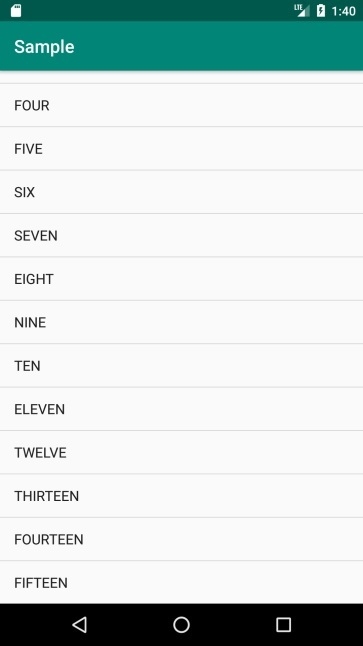
 Data Structure
Data Structure Networking
Networking RDBMS
RDBMS Operating System
Operating System Java
Java MS Excel
MS Excel iOS
iOS HTML
HTML CSS
CSS Android
Android Python
Python C Programming
C Programming C++
C++ C#
C# MongoDB
MongoDB MySQL
MySQL Javascript
Javascript PHP
PHP
- Selected Reading
- UPSC IAS Exams Notes
- Developer's Best Practices
- Questions and Answers
- Effective Resume Writing
- HR Interview Questions
- Computer Glossary
- Who is Who
How to put a ListView into a ScrollView without it collapsing on Android?
This example demonstrates how to put a ListView into a ScrollView without it collapsing on Android.
Step 1 − Create a new project in Android Studio, go to File ⇒ New Project and fill all required details to create a new project.
Step 2 − Add the following code to res/layout/activity_main.xml.
<?xml version="1.0" encoding="utf-8"?> <ScrollView xmlns:android="http://schemas.android.com/apk/res/android" xmlns:app="http://schemas.android.com/apk/res-auto" xmlns:tools="http://schemas.android.com/tools" android:layout_width="match_parent" android:layout_height="match_parent" tools:context=".MainActivity"> <LinearLayout android:layout_width="match_parent" android:layout_height="match_parent" android:orientation ="vertical" > <TextView android:layout_width="wrap_content" android:layout_height="wrap_content" android:layout_marginTop="19dp" android:text="hello_world" /> <ListView android:id="@+id/listView" android:layout_width="fill_parent" android:layout_height="fill_parent" /> </LinearLayout> </ScrollView>
Step 3 − Add the following code to src/MainActivity.java
package com.example.sample;
import android.support.v7.app.AppCompatActivity;
import android.os.Bundle;
import android.widget.ArrayAdapter;
import android.widget.ListView;
public class MainActivity extends AppCompatActivity {
private String listview_array[]={ "ONE", "TWO", "THREE", "FOUR", "FIVE", "SIX", "SEVEN", "EIGHT", "NINE", "TEN" };
ListView myList;
@Override
protected void onCreate(Bundle savedInstanceState) {
super.onCreate(savedInstanceState);
setContentView(R.layout.activity_main);
myList=(ListView) findViewById(R.id.listView);
myList.setAdapter(new ArrayAdapter<String>(this,android.R.layout.simple_list_item_1, listview_array));
Helper.getListViewSize(myList);
}
}
Step 4 − Add the following code to src/ Helper.java
package com.example.sample;
import android.util.Log;
import android.view.View;
import android.view.ViewGroup;
import android.widget.ListAdapter;
import android.widget.ListView;
public class Helper {
public static void getListViewSize(ListView myListView) {
ListAdapter myListAdapter=myListView.getAdapter();
if (myListAdapter==null) {
//do nothing return null
return;
}
//set listAdapter in loop for getting final size
int totalHeight=0;
for (int size=0; size < myListAdapter.getCount(); size++) {
View listItem=myListAdapter.getView(size, null, myListView);
listItem.measure(0, 0);
totalHeight+=listItem.getMeasuredHeight();
}
//setting listview item in adapter
ViewGroup.LayoutParams params=myListView.getLayoutParams();
params.height=totalHeight + (myListView.getDividerHeight() * (myListAdapter.getCount() - 1));
myListView.setLayoutParams(params);
// print height of adapter on log
Log.i("height of listItem:", String.valueOf(totalHeight));
}
}
Step 5 − Add the following code to app/manifests/AndroidManifest.xml
<?xml version="1.0" encoding="utf-8"?> <manifest xmlns:android="http://schemas.android.com/apk/res/android" package="com.example.sample"> <application android:allowBackup="true" android:icon="@mipmap/ic_launcher" android:label="@string/app_name" android:roundIcon="@mipmap/ic_launcher_round" android:supportsRtl="true" android:theme="@style/AppTheme"> <activity android:name=".MainActivity"> <intent-filter> <action android:name="android.intent.action.MAIN" /> <category android:name="android.intent.category.LAUNCHER" /> </intent-filter> </activity> </application> </manifest>
Let's try to run your application. I assume you have connected your actual Android Mobile device with your computer. To run the app from android studio, open one of your project's activity files and click Run ![]() icon from the toolbar. Select your mobile device as an option and then check your mobile device which will display your default screen −
icon from the toolbar. Select your mobile device as an option and then check your mobile device which will display your default screen −

Click here to download the project code

